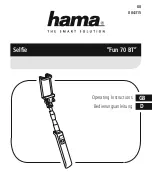
33
20
40
60
80
100
120
140
160
180
200
220
240
260
280
300
320
340
60
60
40
40
20
20
W
E
W
D
ec
l.
E
D
ec
l.
MN
S
22
11
Magnetic declination
North
INITIAL SETTING AND BASIC OPERATION
Approximate Polar Aligning with the Polar Meter
About Magnetic Declination of Compasses
The Polar Meter is optional and it is not included in the AP Mount packages.
1
Loosen the angle lock knob of the Polar Meter and tilt it to an angle that is equal to the altitude of Polaris at your location.
Then, tighten the angle lock knob.
The angle is indicated by the pointer on the altitude scale of the Polar Meter. The altitude is scaled in 5 degree increments.
2
Attach the Polar Meter to the accessory
shoe on the AP mount as shown in the
figure.
3
Change the direction of the AP mount so that the pointer on the compass of the
Polar Meter points N sign on the dial of the compass.
4
Adjust the elevation of the AP mount with the
altitude adjustment bolt so that the bubble in
the bubble level on the Polar Meter comes to
the center of the guide circle on the level.
Next, adjust the direction with the azimuth
adjustment knobs so that the pointer on the
compass falls on the N on the dial of the
compass.
The magnetic declination is a deviation from true nor th or celestial north which may affect the
needle of your compass. It dif fers depending on the area of the earth. Typically the needle of
the compass points 3 to 9 degrees off to the west as you use the compass in Japan. You may
obtain information on the magnetic declination of your location from the Geographical Survey
Institute in your country.
North
North
North
Angled at 35 degrees (Tokyo)
Accessory shoe
Polar axis
Polar axis
Deviation
Bubble level
Azimuth adjustment
knob
Altitude adjustment
knob
Magnetic north
Celestial north
















































